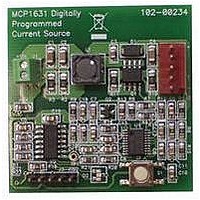MCP1631RD-MCC1 Microchip Technology, MCP1631RD-MCC1 Datasheet - Page 8

MCP1631RD-MCC1
Manufacturer Part Number
MCP1631RD-MCC1
Description
REFERENCE DESIGN FOR MCP1631HV
Manufacturer
Microchip Technology
Type
Battery Managementr
Datasheets
1.MCP1631VHVT-330EST.pdf
(34 pages)
2.MCP1631HV-330EST.pdf
(54 pages)
3.MCP1631RD-MCC2.pdf
(20 pages)
4.MCP1631RD-MCC2.pdf
(328 pages)
5.MCP1631RD-MCC1.pdf
(28 pages)
Specifications of MCP1631RD-MCC1
Main Purpose
Power Management, Battery Charger
Embedded
Yes, MCU, 8-Bit
Utilized Ic / Part
MCP1631HV, PIC16F883
Primary Attributes
1 ~ 2 Cell- Li-Ion, 1 ~ 4 Cell- NiCd/NiMH
Secondary Attributes
Status LEDs
Supported Devices
MCP1631HV, PIC16F883 Device Type
Tool / Board Applications
Power Management-Battery Management
Development Tool Type
Reference Design
Input Voltage
5.5 V to 16 V
Product
Power Management Modules
Mcu Supported Families
MCP1631HV/PIC16F883 Family
Silicon Manufacturer
Microchip
Silicon Core Number
MCP1631HV
Kit Application Type
Reference Design
Application Sub Type
Battery Charger
Kit Contents
Board Only
Lead Free Status / RoHS Status
Lead free / RoHS Compliant
For Use With/related Products
MCP1631HV, PIC16F883
Lead Free Status / RoHS Status
Lead free / RoHS Compliant
MCP1631/HV/MCP1631V/VHV
DC CHARACTERISTICS (CONTINUED)
TEMPERATURE SPECIFICATIONS
DS22063B-page 8
Electrical Specifications: Unless otherwise noted, V
V
Line Regulation
Load Regulation
Dropout Voltage
Note 2, Note 5
Output Delay Time
Output Noise
Power Supply Ripple Rejection
Ratio
Protection Features
Thermal Shutdown
Thermal Shutdown Hysteresis
Note 1:
Electrical Specifications: Unless otherwise indicated, all limits are specified for: V
Temperature Ranges
Operating Junction Temperature
Range
Storage Temperature Range
Maximum Junction Temperature
Package Thermal Resistances
Thermal Resistance, 20L-TSSOP
Thermal Resistance, 20L-SSOP
Thermal Resistance, 20L-QFN
DD
for typical values = 5.0V, T
2:
3:
4:
5:
Parameters
External Oscillator Input (OSC
characterization testing. Signal levels between 0.8V and 2.0V with rise and fall times measured between 10% and 90%
of maximum and minimum values. Not production tested. Additional timing specifications were fully characterized and
specified that are not production tested.
The minimum V
TCV
temperature range. V
Load regulation is measured at a constant junction temperature using low duty cycle pulse testing. Changes in output
voltage due to heating effects are determined using thermal regulation specification TCV
Dropout voltage is defined as the input to output differential at which the output voltage drops 2% below its measured
value with an applied input voltage of V
Parameters
OUT
= (V
OUT-HIGH
IN
must meet two conditions: V
A
for typical values = +25°C, T
OUT-LOW
- V
V
(V
T
OUT-LOW
DROPOUT
ΔV
ΔV
T
SHD_HYS
PSRR
OUT
V
T
Sym
DELAY
V
e
SHD
OUT
OUT
OUT
IN
N
IN
= lowest voltage measured over the temperature range.
XΔ
)
Sym
θ
θ
θ
) rise and fall times between 10 ns and 10 µs were determined during device
T
T
T
/
/
JA
JA
JA
A
J
J
) *10
6
OUT(MAX)
/ (V
IN
Min
-0.3
-2.5
Min
—
—
—
—
—
—
—
-40
-65
—
—
—
—
= 3.0V to 5.5V, F
R
* ΔTemperature), V
IN
+ V
A
≥ 3.5V and V
= -40°C to +125°C for all minimum and maximums.
DROPOUT(MAX)
89.3
Typ
90
43
—
—
—
1000
±0.1
±1.0
Typ
330
525
150
44
18
8
OSC
IN
+125
+150
+150
≥ (V
OUT-HIGH
Max
= 1 MHz with 10% Duty Cycle, C
—
—
—
Max
+0.3
+2.5
650
725
or 3.5V, whichever is greater.
—
—
—
—
—
OUT(MAX)
IN
+ 3.0V to 5.5V
= highest voltage measured over the
Units
(Hz)
°C/W
°C/W
°C/W
Units
%/V
°C
°C
°C
µV/
mV
mV
dB
µs
°C
°C
%
+ V
1/2
DROPOUT(MAX)
Steady State
Transient
Typical 4 Layer board with
interconnecting vias
Typical 4 Layer board with
interconnecting vias
Typical 4 Layer board with
interconnecting vias
(V
V
I
I
I
V
I
1 µF
f = 100 Hz, C
I
V
C
© 2008 Microchip Technology Inc.
L
L
L
R
L
L
IN
IN
INAC
IN
OUT(MAX)
= 1.0 mA to 250 mA, Note 4
= 250 mA, V
= 250 mA, V
L
= 50 mA, f = 1 kHz, C
= 100 µA,
OUT
= 50Ω resistive
= 0V to 6V, V
= 0 µF, V
≤ 16V Note 2
=100 mV pk-pk,
.
Conditions
Conditions
).
+ V
R
OUT
IN
R
R
= 1.2V
DROPOUT(MAX)
= 0.1 µF,
= 5.0V
= 3.3V
OUT
= 1 µF,
= 90% V
OUT
=
) ≤
R
,













